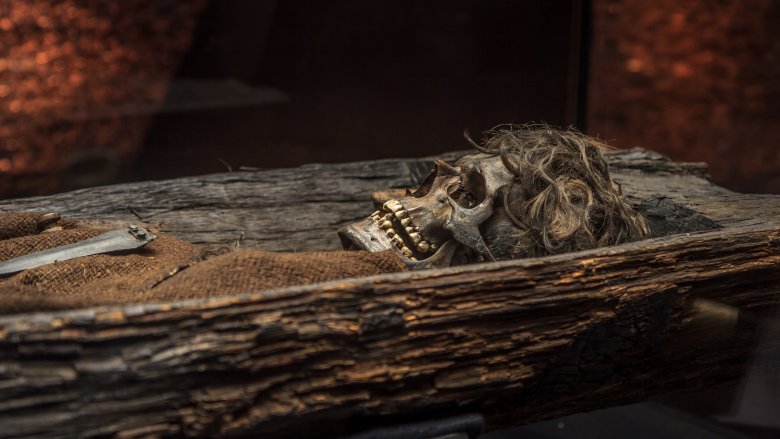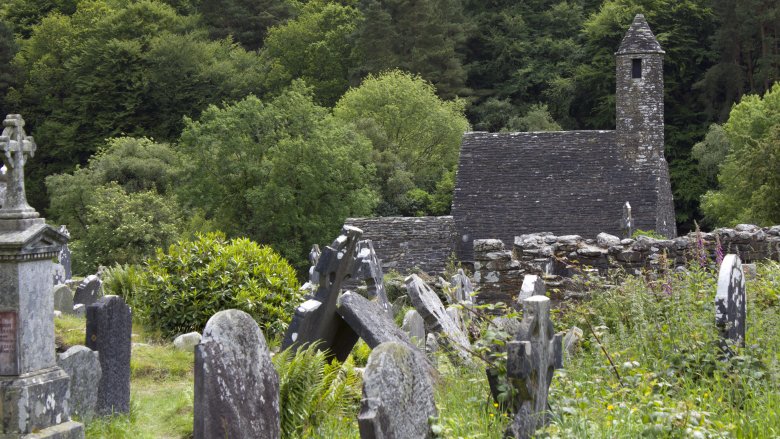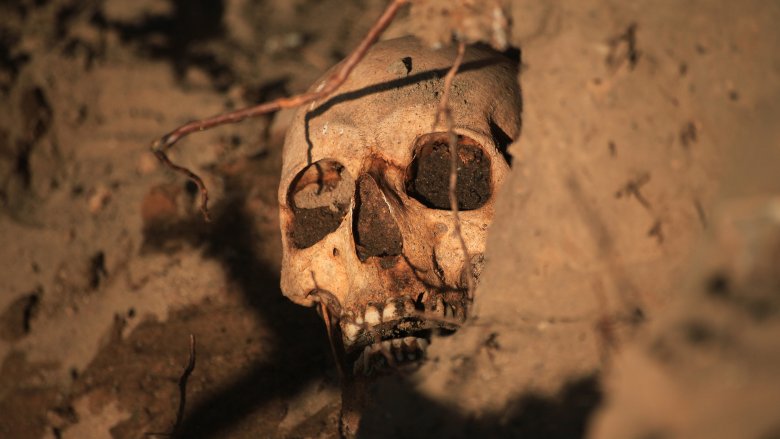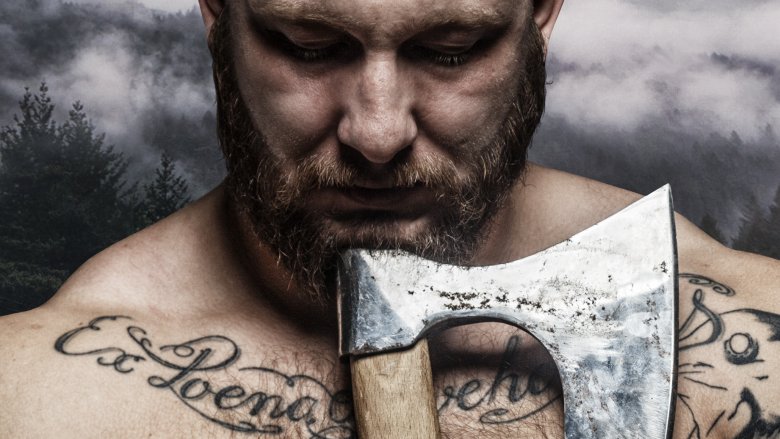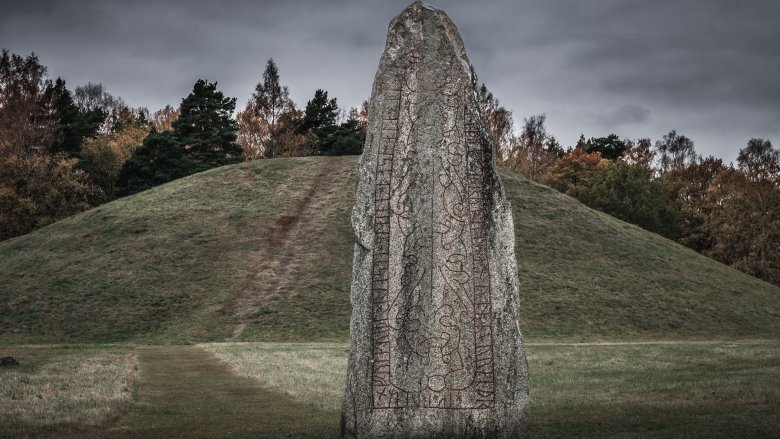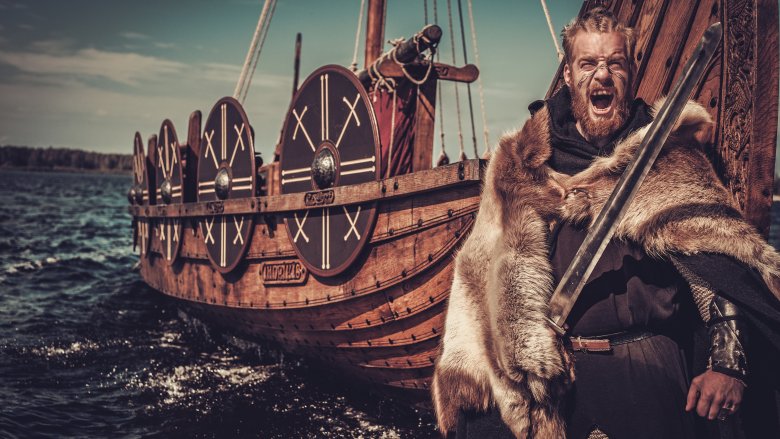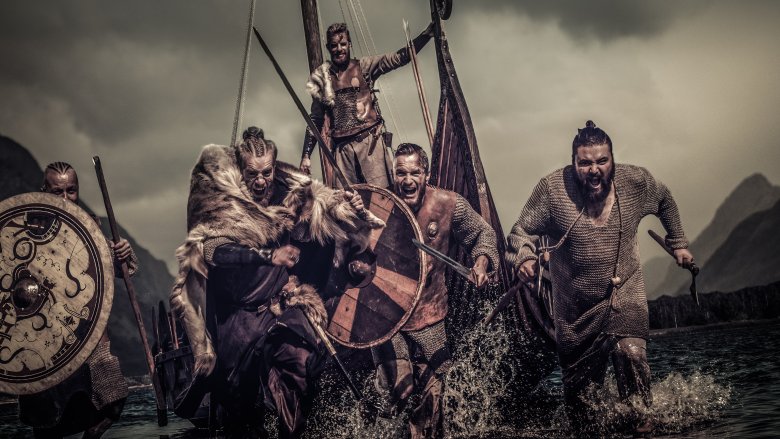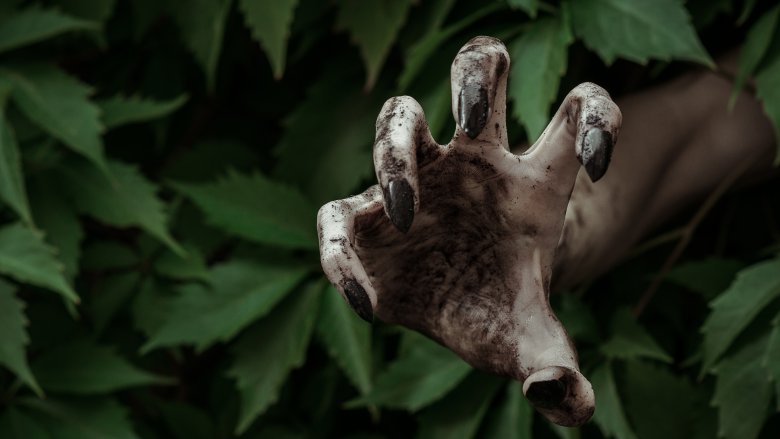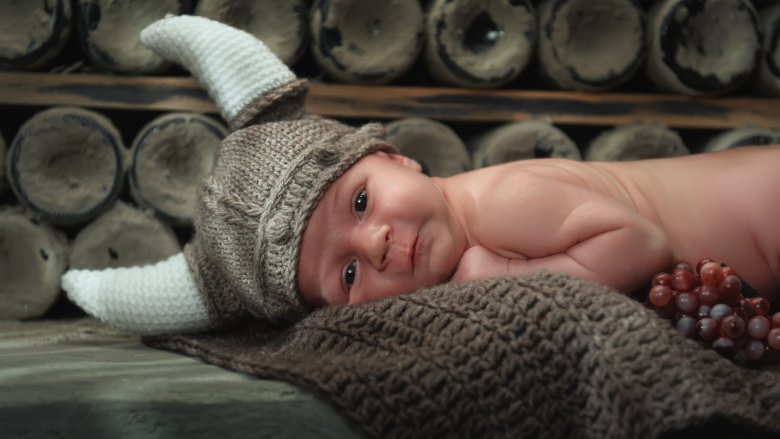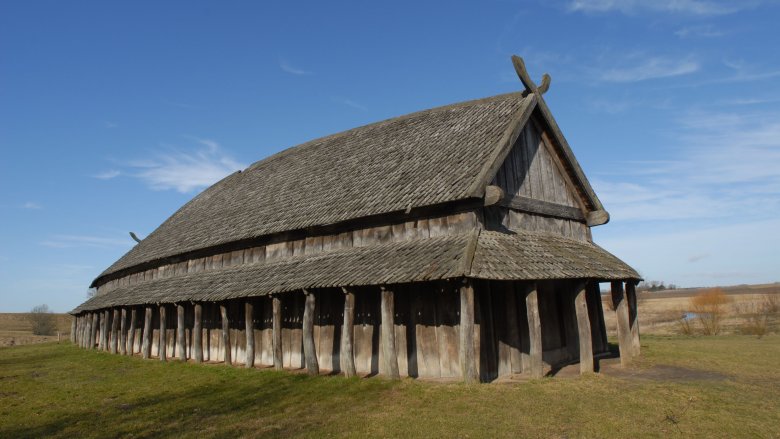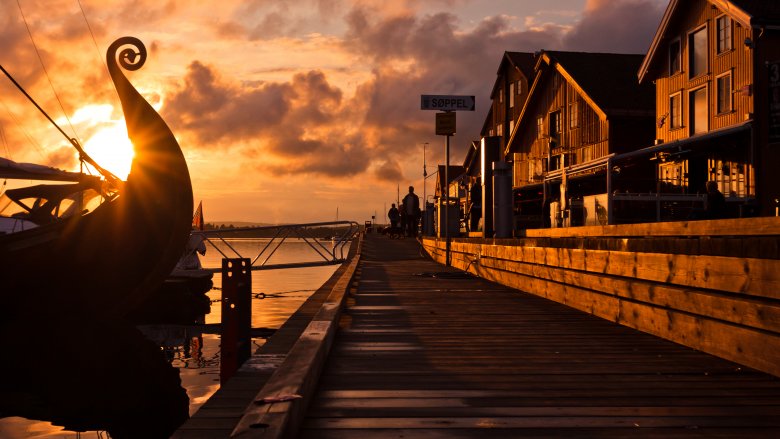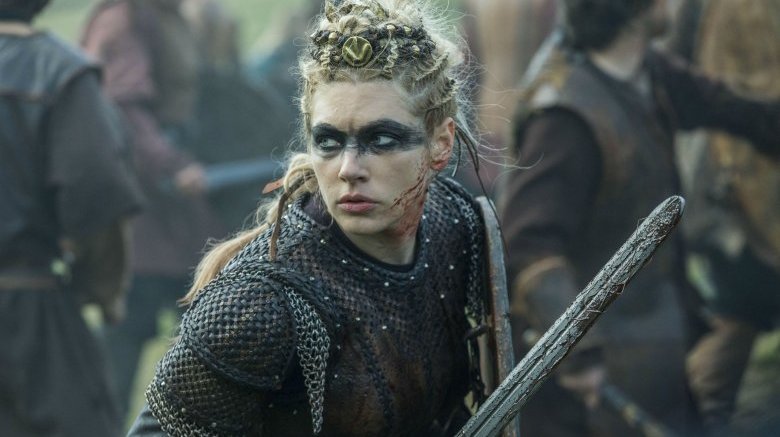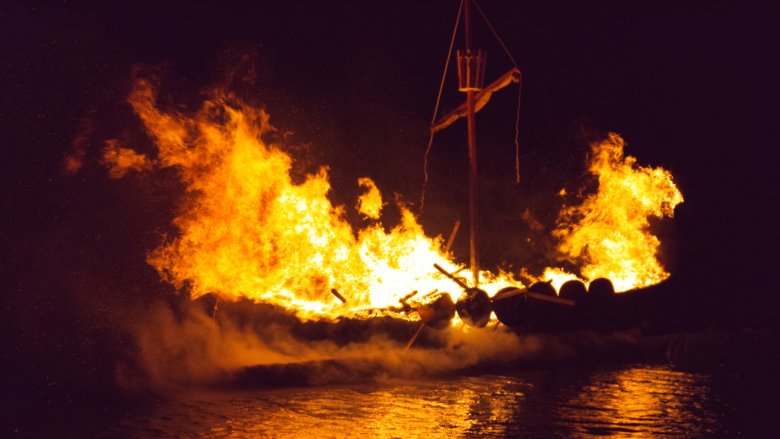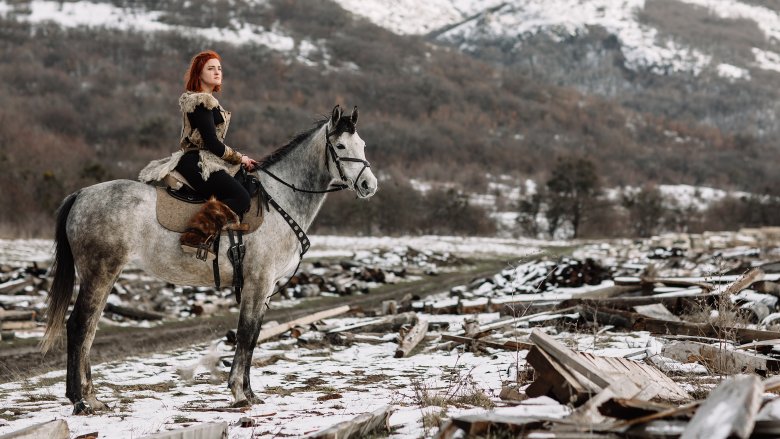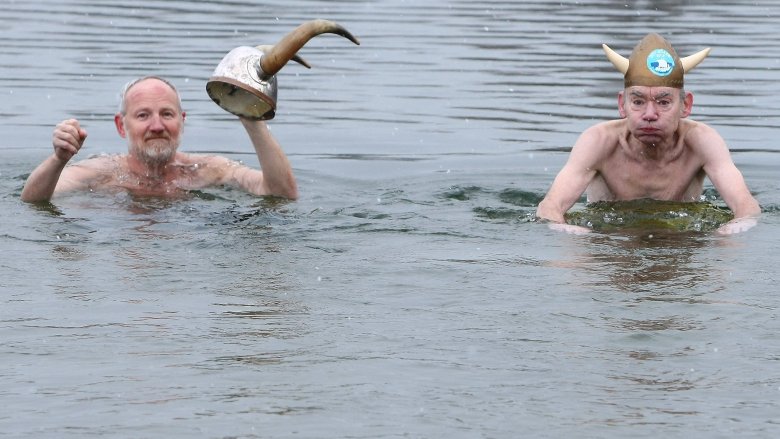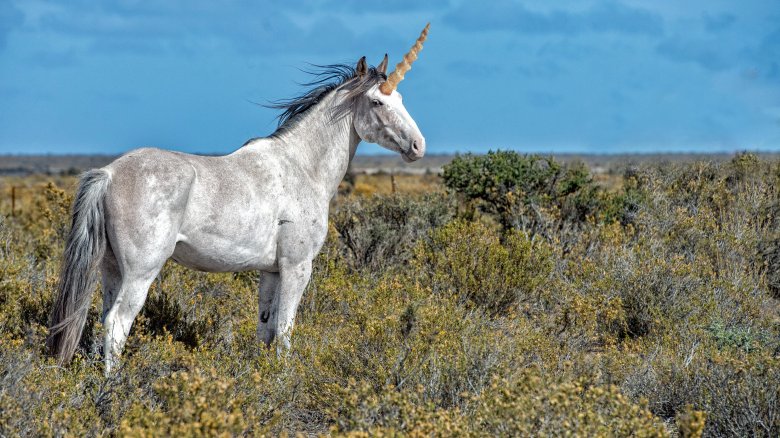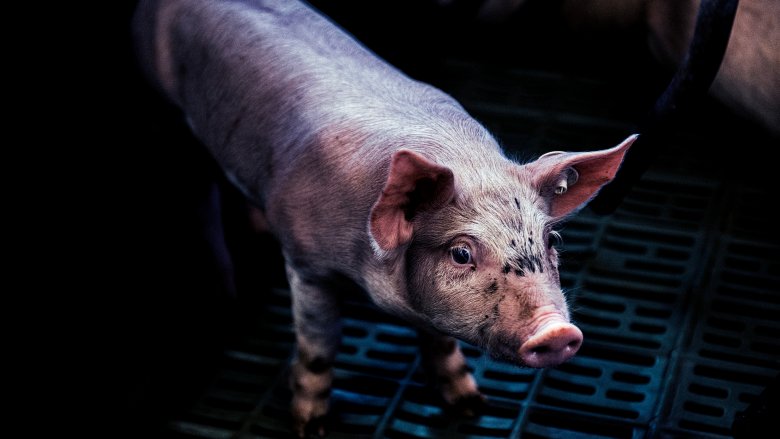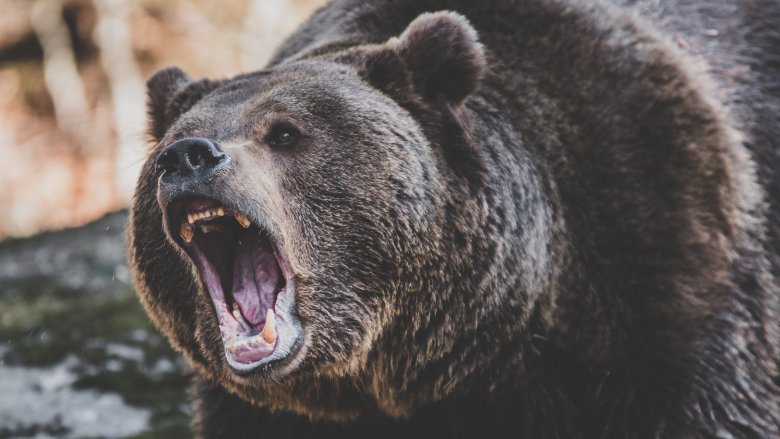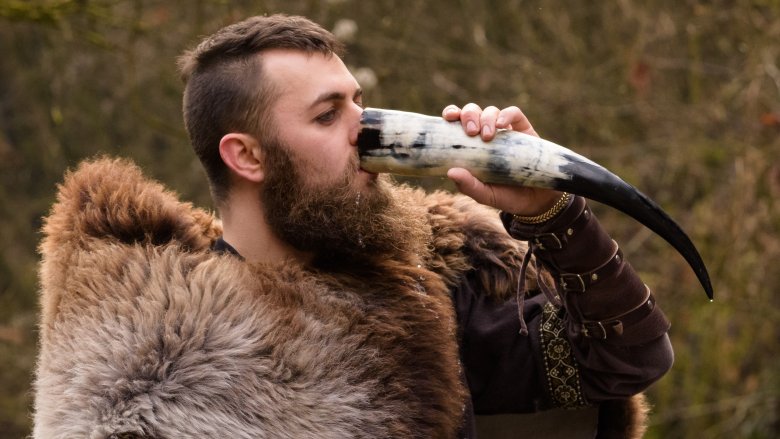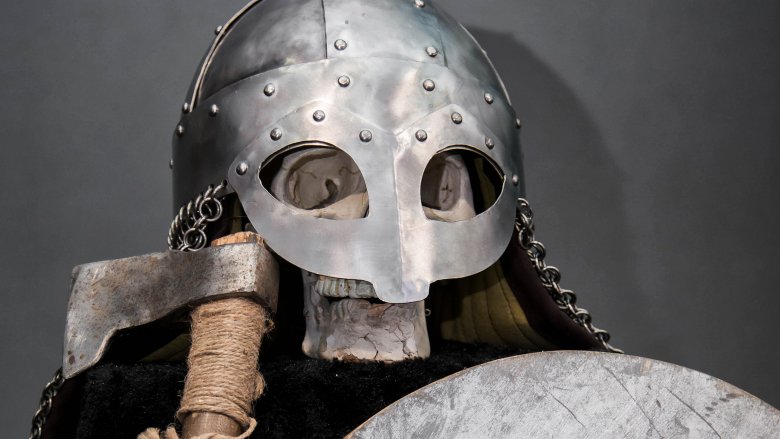Messed Up Things That Actually Happened During The Viking Era
There's no shame in wishing you were a Viking. We could all do with a little looting and pillaging every so often — it's just human nature. But even if you're a fan of the TV show Vikings, you probably don't know what you're in for. You're not alone, because according to the BBC, a lot of the knowledge we have about the Vikings comes secondhand. Even if you look at what was written about them, it's a lot of hearsay and exaggeration. But don't worry — we do know some things for sure, and it's just as messed up as you'd expect.
Sacrificing slaves as 'burial gifts'
The Vikings are best known for taking to the high seas in those cool longboats, but a less cool part of their culture was the huge network they set up to trade in slaves. National Geographic says their entire economy was built on the slave trade, and a disturbing discovery made in the 1980s helped confirm they kept slaves for themselves and even sacrificed them on the deaths of their masters.
The University of Oslo published its findings on a site in Flakstad, Norway, in the Journal of Archaeological Science in 2014. The burial ground dated to some time late in the Iron Age — between 550 and 1030 — and 10 people were buried there. Three were alone, but there were two double burials and one triple burial, and they also say the remains of four skeletons didn't have heads.
It's not even the only place headless corpses have been found buried alongside other Viking remains, and it's evidence of a practice written about in Icelandic sagas: burying sacrificed slaves with their dead masters. The slaves are decapitated — done to differentiate between different social classes — then left in the grave as "grave gifts" for the upper-class slave owners. You can't help but wonder if they were actually decapitated to avoid those awkward conversations in Valhalla.
Monasteries were raided for eunuchs
The Vikings definitely didn't invent slavery, but they took it to a whole new level. According to historian John Haywood (via History), most of Ireland's largest cities — including Dublin and Limerick — began life as hubs for the Viking slave trade. They stayed that way for hundreds of years, because they were conveniently located for those Viking raiders you've heard stories about, plundering and pillaging monasteries up and down the coasts of Ireland, Britain, and France. What's more, Vikings targeted monasteries in particular not because they were looking for riches or hated Christianity, but because they knew they could kidnap literate men who could be castrated and sold off as eunuchs.
Historian Mary Valente (via Medievalists) says there was a huge demand for slaves and for eunuchs. Most demand came from the Middle East and Byzantium, where eunuchs would be put to work as teachers, harem guards, in various governmental roles, or as palace servants. There was plenty of demand for these men, and it was such an industry it formed the backbone of the Mediterranean slave trade. Viking raiders saw monasteries as a pretty literal gold mine, and once their slaves entered their trade network, they'd be shipped off to Venice to be castrated and sold. Puts all that raiding in a whole different light.
Teeth filing was a status symbol
Take a look online and you can see all kinds of body modification, but the Vikings had their own ideas about it. In 2006, anthropologist Caroline Arcini (via National Geographic) published her findings on the 557 Viking skeletons she looked at. There were 24 of them that had a series of horizontal lines filed into their teeth, and if the idea of taking a sharp object to your teeth and filing in grooves doesn't make you cringe ... you're not of this world.
No one's sure just why these particular people decided to do this particular horrible, horrible thing, but William Fitzhugh of the Smithsonian National Museum of Natural History thinks they may have gotten the idea after making contact with West African peoples. Native American tribes have been found to have filed their teeth in a similar horizontal pattern, though, while Africa's teeth modifiers sharpened their pearly whites into points. Wherever they got the idea, the practice is so precisely done anthropologists believe it took some serious, professional-level skill to do it right. Maybe ask for a touch-up the next time the dentist starts scraping away.
The St. Brice's Day massacre
You can't be a ruthless marauder without some consequences. You know what they say about payback, and in 2010 British archaeologists uncovered evidence of some pretty grisly events that had the Vikings on the receiving end of some insanely sharp weapons. Researchers from Oxford Archaeology (via The Independent) excavated a site just outside Weymouth and found that the 55 Vikings buried in the mass grave weren't just executed, they were mutilated.
Reconstructing the scene, archaeologists say the men were forced to strip (no clothing artifacts were found with them), then decapitated with blows from the front to ensure they could see it coming. Faces and right ears showed extensive damage.
It was likely the St. Brice's Day Massacre, which happened on November 13, 1002, by order of England's King Ethelred the Unready. According to Archaeology, the English had been paying for peace even as the Vikings continued to raid and pillage. Ethelred had enough and ordered a massacre of any Vikings his men could get their hands on. It's unclear how many died, but the Danish king, Swein Forkbeard, was beset with grief over the execution of his sister and her child, and England would be answering to its Viking king by 1013, when Forkbeard unleashed holy hell on England. Unready, indeed.
Human sacrifice
Let's start with the story first because it's pretty epic. Some contemporary sources tell us about sacrifices made to Odin, like the 99 people, horses, dogs, and hawks that were sacrificed every nine years. There's another story that says Vikings assembled at Uppsala every nine years to make sure they were still in good with the gods by sacrificing humans, horses, and dogs in sets of nine, then hanging them from the trees of the holy grove.
Whether that story is true or just some anti-Viking propaganda is debated, but the National Museum of Denmark says it's at least partially true. Evidence came when archaeologists excavated a sacrificial site at Trelleborg and found a well filled with animal bones and the skeletons of at least five human sacrifices. Four of those people were children between the ages of 4 and 7.
Don't worry, it gets even darker. According to historian Harry Brown (via Medievalists), all that pop culture nonsense about willing sacrifices is nonsense. Brown says there are no actual sources that mention sacrifices being willing participants. In fact, it's the opposite. Ibn Fadlan, writing in the 10th century, told the tale of a slave girl who tried to back out of being a sacrifice. Instead of being freed, she was dragged to her execution — a death that only came after she was assaulted by six different men. Just goes to show that history was disgusting.
Vikings were so crazy they may have developed criminal profiling to cope
So, you're a Viking. You make your living pillaging, raiding, and kidnapping. You're really good at sailing the high seas, and you're even better at cleaving skulls. But you have to go home sometime, so what happens then? Do you turn off the bloodthirsty?
According to Dr. Tarrin Wills of the University of Aberdeen, Vikings couldn't turn off the crazy and their more civilized neighbors had to figure out how to deal with them.
That's where criminal profiling comes in. Wills says the return of the Viking horde created such a problem on the home front that Icelandic sagas were written, in part, to warn homegrown Vikings what to look out for. There are a lot of physical descriptions in the sagas, which is a bit out of place. Wills says sagas and other literature were usually strictly plot-focused, so descriptions of heavy eyebrows and receding hairlines had to serve another purpose. He believes it's documentation of the testosterone-heavy physical features of the men who caused the most trouble at home, and it was their way of linking physiology with personality. This 10th-century sort of criminal profiling was pretty practical, and told audiences they should be afraid of guys like Egill, with his bushy beard and broad shoulders. So shady.
Viking berserkers were very real
The idea of the Viking berserker is so insane that they've firmly entrenched themselves in the realm of fantasy character classes. But they were real people who would go hardcore badass on the enemy, so dangerous that even other Vikings sort of gave them a wide berth.
According to researcher Ruarigh Dale from the University of Nottingham, our image of berserkers goes back to the sagas written by Snorri Sturluson. We also know they were used in battle, but only after people thought very carefully about it. In 1030, Olav Haraldsson used a group of berserkers as the core of his troops, and their complete failure to follow orders led to the loss of the fight and the ultimate end of the king (via History Extra).
No one really knows where berserker rage came from, and it's such a powerful thing it's usually attributed to Odin's influence. Skeptoid's Brian Dunning has another (pretty dark) theory. He suggests their supernatural rage and anger, triggered on the battlefield, falls into the super-extreme end of a diagnosis of post-traumatic stress. Other descriptions of berserkers include suffering from an almost seizure-like episode before the rage, a long depression afterward, and a dissociative episode of uncontrollable anger. Berserkers weren't always raging, but when they were, perhaps it was because of severe PTSD.
Trimming the fingernails of the dead
This one's going to get squicky, so apologies in advance. According to Snorri Sturluson's Prose Edda (via Spangenhelm), part of the Viking funeral rites involved cutting the fingernails and toenails of the deceased to help prevent — or at least postpone — the end of the world.
There are all kinds of dark things that were said to happen with the fall of Ragnarok, and one of those horrible little details includes the sailing of the ship Naglfar. Naglfar would carry the giants into battle, and the entire ship was made from the fingernails and toenails of the dead. The more people who were buried with untrimmed nails, the bigger the ship would be. Bigger ship equals more giants onboard, and no one wants more giants. No one wants a huge ship made from toenails, either.
There was a lot of infanticide going on
Infanticide was shockingly common throughout history — just look at the burial sites we've found for Roman babies. The Vikings were no different, and they had potential infanticide built into their naming beliefs.
Christening a child with a particular name comes from the Vikings (via Spangenhelm). Their ritual was called Ausa Vatni, and it only happened after parents examined their child and decided he or she was worth raising. Children who weren't worth keeping were left to die by exposure, and according to historian Nancy L. Wicker's treatise on infanticide, it was frequently done with girls. Lots of girls. Records of Viking households suggest boys outnumbered girls at least four to one and even up to nine to one. That's not how biology works, so something must have happened to those girls.
It also has to be said the Vikings didn't view the death of an infant via exposure as murder, as long as it was done before the Ausa Vatni. After the child was named and accepted into the family, it was a problem, but before? Totally cool.
Some serious carbon monoxide poisoning
Viking longhouses are pretty cool. Who doesn't want one in their backyard for barbecuing meats and drinking lots of mead? There's a catch, though, and it became painfully clear when researchers from Denmark's Aarhus University built their longhouse replicas, lit some fires, then tested the air.
The houses were as authentically Viking as they could get, made with wattle and daub walls and thatching. They lit fires in the center of each house and monitored interior conditions for 15 weeks of winter. When they compared their findings to what the World Health Organization deems safe, they found those cool Viking longhouses were constructed in a way that encouraged the collection of fine particles, nitrogen dioxide, and carbon monoxide. You know, the stuff we make special detectors to warn us about so we don't die snoring.
While there was a hole in the roof for smoke, not all the smoke left. That same roof design trapped a lot of it, and once it cooled, all the nastiness in the air dropped to ground level. They say short-term exposure wasn't too dangerous, but long-term exposure — like Viking women and children would have had — leads to things like respiratory infections, bronchitis, cerebrovascular disease, and cancer. Ah, the good old days.
Worm infestations
This one starts out pretty gross, but don't give up. After the gross part, it gets really weird.
Archaeology isn't all the stuff of Indiana Jones, and sometimes, it's about poop. In 2015, a team of scientists from the University of Copenhagen were excavating their way through Viking poop in a latrine (via Science Nordic). What they found was a ton of parasite eggs, which one scientist even called "fascinating." That last is probably up for debate, but we do know Vikings were pretty constantly plagued by serious infestations of intestinal worms.
Infestations were so serious that Viking genetics actually changed to help them fight off the effects of the parasites. According to Archaeology, the Vikings developed an abnormal version of a molecule called alpha-1-antitrypsin, or A1AT. Hundreds of years ago, it helped them fight off the inflammation and damage done by their worms, but it has a completely different impact on carriers of the abnormal A1AT today. The Viking A1AT is the only genetic factor scientists have linked to respiratory diseases like emphysema and COPD. Essentially, those abnormal genes have now gotten bored without parasites to play with, so they've started causing some serious havoc with other areas of the body. Thanks a lot, Vikes.
Maybe this especially brutal form of execution
A warning: This is a really gross concept. Just ... nasty. So heads up and whatever.
You probably thought drawing and quartering was pretty messed up, but this particular form of messed up makes drawing and quartering look like gently drifting off to sleep. According to the Smithsonian, the Vikings have long been famous for the "blood eagle," which sounds all regal and super-cool but don't let the name lull you into a false sense of awesome-ways-to-die. The blood eagle execution basically involved carving up someone's body to make it look like an eagle, wings and all, and if you're having trouble imagining that just picture what would have to be done to your rib cage in order to make it resemble wings. And after the rib hacking, because for some reason you'd still be alive at this point though we're not sure how, your executioners would pour a salt solution into your wound, and then they would pull out your lungs and arrange them over your rib-wings so they would hopefully flutter like a bird as you died.
The good news in this terror is that we don't really know if the blood eagle was ever actually a thing. For centuries, historians believed it was — but most of the evidence for its use came from the Norse and Icelandic sagas, which are questionable historical sources since they were almost certainly embellished for entertainment value. So believe it if you choose to — the History Channel's Vikings certainly did. But it's probably best taken with a grain of salt, or in this case, a teaspoon of salt solution.
Who needs X-rays when we have really strong onion soup?
Even modern people believe in the power of soup as medicine — as a kid, your mom probably made you chicken soup whenever you had a cold, and there's a good chance you still crave it whenever you're feeling under the weather. And you've probably also heard how drinking bone broth can help you sleep, make your bones stronger, and totally solve climate change. Not really that last one, but yeah, there's some hype.
Anyway the Vikings used soup as medicine, too, onion soup specifically, but it was more of a diagnostic tool. A really gross diagnostic tool. According to ISAAA.org, Viking healers would force-feed a strong onion soup to any warrior who had a wound to the abdomen. The onion soup essentially served as a canary in the colon. If the healer could smell the soup through the wound, that meant that the injury included the stomach or intestines, which also meant it was fatal. That was pretty handy knowledge because it meant that the healer could move on to another patient rather than waste time and effort with the guy who was as good as dead. Compassionate people, those Vikings.
Cutting off your nose to spite the Vikings
Being a Viking was a pretty great job because if you didn't die you got to loot and pillage, and if you did die, then you got to go to Valhalla and hang out with Thor, which basically parallels the modern American fantasy of hanging out with Bruce Lee or Arnold Schwarzenegger in the afterlife, except that Arnold Schwarzenegger isn't actually dead at the moment.
Anyway it was pretty cool for the Vikings but for everyone else it was absolutely freaking terrifying, and when you knew that the Vikings were on their way you really only had two rational options: run away, or crap your pants to make yourself lighter and then run away.
According to Britannia, the Vikings had such a terrifying reputation that one group of nuns living in a Scottish convent decided that they'd better just go ahead and disfigure themselves rather than face potential defiling at the hands (and other body parts) of an invading Viking force. So instead of running, for reasons that are really, really, really not very clear, they cut off their own noses and just as an extra precaution they also cut off their own upper lips. When the Vikings arrived, they were sufficiently put off by the horrible scene to not be interested in defiling anyone, but they were also so enraged that they decided to burn down the convent and everyone in it. So not only did the whole nose and lip removal thing suck for those nuns, but they all ended up dying horribly anyway.
Don't touchwood, because that's disgusting
When you first learned to build a campfire, there were probably some matches involved, and maybe some lighter fluid, and maybe one of those weird compressed log thingies from Walmart because building a campfire is hard. But the point is, we modern people have tools that make the impossible task of lighting and maintaining a fire more or less doable. The Vikings did, too, but they were Vikings so they naturally had to have some gross and horrible way to build a fire because obviously.
The Viking method of fire starting involved a nifty little homemade tool that they could carry around with them, making it possible to start a fire pretty much anywhere. According to the Cambridge University Press the tool was made from a fungus called touchwood, which grows on the bark of beech and oak trees. The Vikings would harvest it and then beat and burn it until it was flat and thin like a piece of felt. Then — and here's the gross part — they would boil it in human urine. Why did they do this? Because urine contains sodium nitrate, which turned the touchwood felt into something that would smolder instead of burn. So they could take the gross, smoldering thing wherever they needed to go, and they could use it to build fires so they could roast meat over the urine-fueled flames. And everyone would be all, "That's okay, I lost my appetite." Heaven only knows how they discovered this lovely technique.
It's almost as if they didn't like horses that much
Horses were really valuable during the Middle Ages. People depended on them for transportation, warfare, and to make themselves look cool while wearing armor and cantering across the grassy hillside. So it seems amazing to think that anyone could have viewed horses as an expendable resource, but evidently the Vikings did.
According to the National Museum of Denmark, horses were frequent victims of the infamous blot sacrifice, which basically involved spraying everything in sight with the blood of very unfortunate animals, horses in particular. Participants would collect the blood in large bowls and then use twigs to splatter it all over the walls, the altars, and the people. Then everyone would have a fine meal of horse meat afterward, so at least they weren't wasting it.
Now, it is true that any sacrifice was believed to have the greatest effectiveness when the thing being sacrificed had value — otherwise the word "sacrifice" wouldn't really be accurate. You don't go "sacrificing" all of the village rats or anything because everyone knows that killing pests isn't really sacrificing anything except maybe all those bubonic plague fleas. So horses must have been valued in that sense ... except that Vikings also did other seriously callous stuff with them, like pit two stallions against each other for sport and then bet on which one would kill the other. Which doesn't really seem like something you'd do with creatures you valued, but the Vikings did like to be mysterious, didn't they?
And you thought the Super Bowl could be violent
Just like pretty much all humans, the Vikings enjoyed sports. That's cool, right? At last, something we have in common with them. Except no, to the Vikings, sports like American football and boxing would have seemed adorable, something for the kids to enjoy while the real men engaged in the real sports.
Swimming, for example, sounds pretty basic, but the Vikings would have almost certainly whooped Michael Phelps' raisiny behind if they were all playing by Viking rules because "swimming" was just a tame label for a game more accurately described as "see which Viking can drown the other Viking." According to Hurstwic, in a Viking swimming competition, the goal was to hold your opponent under the water for as long as possible.
Even the more innocent-seeming games could still be potentially dangerous, since Vikings were evidently notoriously bad sports and would often just start pummeling each other when things weren't going their way. (We've all been there.) And because you were in no way required to stay in the game if you thought you were going to get hurt, it was basically your fault if you did get hurt. Viking logic was ... something else.
Psst, you wanna buy a unicorn horn?
Conning people is probably one of the oldest professions there is. There was almost certainly at least one caveman who was good at conning other cavemen into believing that the mangy dog hide they were about to purchase for six seashells and an elk haunch was actually genuine wolfskin. So it's unsurprising that Vikings engaged in product misrepresentation, too, but theirs was especially delightful. According to Vintage News, the Vikings would trade with the Inuit people for narwhal tusks (and they probably also hunted the creatures themselves), and then they would sell the tusks as "unicorn horns," which let's face it people would totally be doing today if they thought they could get away with it. And actually people probably are doing it today because you can get away with it because we live in a world where humans can be conned into buying other people's used tissues, so there's that. Don't get any ideas, though, because hunting narwhals is generally frowned upon, and the European Union has banned the import of their tusks.
Anyway, by the Middle Ages, there were plenty of people in Europe who thought that unicorns were not only real but also had magical powers in their horns. So really, you've got to at least admire the Vikings' ability to know a sucker when they see one.
The typical Viking longhouse seriously needed some Glade plug-in air fresheners
This particular little tidbit is not especially unique to the Vikings, but it does have enough of a yuck factor to make it worthy of mention. According to Danish Net, the average Viking family didn't really have a barn to keep their animals in so they did what any rational non-barn-owning person would do — they just kept all their farm animals in the house. This practice served a couple of important purposes. First, it ensured that Svorg from the longhouse down the street, who you nearly killed in a swimming match a couple of days ago, wouldn't try stealing your cow out of spite. Second, it brought additional sources of heat into your home, thus helping Vikings save money on their electricity bills.
We're very sure that there was some sort of poop-cleaning routine in a Viking longhouse but still, you'd save to have someone standing behind the cows with a sack just about all the time if you expected to keep the smell anywhere close to under control, so it's probably safe to say that a Viking longhouse was a stinky place. Warm and somewhat energy-efficient, maybe, but stinky.
You know dogs are just not badass enough
The Vikings did keep dogs and cats and were quite fond of them — according to Ancient History Encyclopedia, there is evidence that they would sometimes bring their dogs and cats along on raids. That sort of makes sense because it seems like dogs might be useful on a raid, though we really have no idea what the deal was with the cats. Perhaps they provided ankle-attack support in battle.
The Vikings weren't satisfied with mere dogs and cats, though, because they were Vikings and that meant they had to have awesome pets to round out their collection of ordinary pets. So on a slow war day, the Vikings would go out and raid bear dens and then take the cubs home and raise them as "house bears." If that seems crazy to you, just imagine for a second how handy a pet bear would be for keeping the slaves in line and making sure that neighborhood kids stay off your lawn.
But even Viking tolerance has its limitations, and the extraordinary badassery of owning a giant, potentially person-eating a bear as a pet could not compete with the practicality of not wanting your neighbor's bear to kill your livestock and/or family members. So some communities would hit bear-owning families with heavy fines when their pets got out of hand, and others just banned house bears outright, so those badass bear owners had to learn to be satisfied with their ankle-attacking battle cats instead. We can't always have nice things.
And you thought your family was insufferable at Christmas
When you think of Vikings you probably think of Odin, Valhalla, and Thor with his weird little not-very-manly goat cart thingy. But of all the things that come to mind when you think about Vikings, Christmas is probably not one of them. Imagine Vikings gathered around the Christmas tree, exchanging thoughtful gifts, singing Silent Night, and then pummeling each other because Svorg was singing off key again.
So it will probably surprise you to hear that Christian Vikings did exist. They were a much later incarnation, but eventually Christianity came to Norway and the Norse people decided to roll their winter solstice celebration into a Christmas celebration. They were still basically Vikings at heart, though, so it's not like they could just be all "what would Jesus do," at least not right away. So the Viking Christmas was pretty much all about getting drunk and perhaps barfing on your kid's Christmas pony or maybe wrestling with your house bear.
According to Serious Eats, the Christian Vikings were so serious about their holiday parties that King Haakon the Good decreed that not only did his people have to brew beer especially for the season, they had to drink it, too, and if they didn't then they were subject to fines and loss of property. Which doesn't sound awful if getting drunk and barfing on your kid's Christmas pony was something you'd be doing anyway, but if you have work or warring to do the next morning, well, that might be a problem for you.
My decapitated head bit me
Of all the badass things the Vikings did, riding around with the decapitated head of an enemy dangling from your saddle was probably the most badass of them all. Your friends would be all, "Look at what a boss Svorg is!" And all your enemies would be saying, "Crap, I'd better steer clear of that dude!" And then the decapitated guy would be thinking, "Dang, I really wish I could bite this jerk on the leg or something."
Funnily enough, that third piece actually happened ... at least according to the sagas, which probably-definitely contain a tall tale or two. But according to the legend, it ended very badly for the total boss who was on the receiving end. His name was Sigurd the Mighty, and he was taken down by the teeth of his decapitated enemy when they scratched his leg while he was riding around with the head hanging off the side of his horse. So that's embarrassing or whatever, but it's really just a flesh wound. Of course, then the wound got infected and Sigurd the Mighty died. And the decapitated head thought, "Not bad for a flesh wound."
